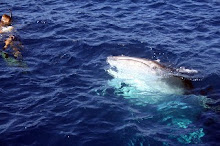And suddenly the sharks were back. We have had a stunning week with sharks seen every day.
 I took this photo on Friday afternoon. It was a windy, rainy and choppy afternoon but we stuck through it only to be teased by numerous 'simmers' - little boils that come up quickly and disappear just as quickly. Nevertheless, lady luck shone down on us and we saw three whale sharks. I love this image:
I took this photo on Friday afternoon. It was a windy, rainy and choppy afternoon but we stuck through it only to be teased by numerous 'simmers' - little boils that come up quickly and disappear just as quickly. Nevertheless, lady luck shone down on us and we saw three whale sharks. I love this image:
It really gives an impression of how impressive their huge tails are. 2 metres high!!! Wow. Formidable.
Taking photographs of the whale sharks has proved to be surprisingly challenging. Rather hit and miss actually. Alot depends on the amount of plankton in the water - the more plankton, the more food for the sharks, but also, the more backscatter and disturbance in the image.
 One trick that has worked well for me is to hold the camera at least a foot below the surface of the water. Just below the surface is generally where the plankton is at its most dense and photos taken from just a little deeper will often produce great rewards. In the image to the left, you can see the effects of plankton backscatter. You can
One trick that has worked well for me is to hold the camera at least a foot below the surface of the water. Just below the surface is generally where the plankton is at its most dense and photos taken from just a little deeper will often produce great rewards. In the image to the left, you can see the effects of plankton backscatter. You can also see how dense the plankton is near the surface alongside the shark. Hold the camera just a little lower and the photo comes out like this:
also see how dense the plankton is near the surface alongside the shark. Hold the camera just a little lower and the photo comes out like this: There is no need to dive down to take great images of whale sharks. In fact, most of my favorite images were taken at the surface. Being at the surface, the lighting is always great - so your photos come out with more brilliance and I find that snorkelers at the surface disturb the sharks alot less than breath-hold divers.
In our next post, I'll talk a little more about whale shark photography. Any questions? Send me a comment. Happy Sharking!

No comments:
Post a Comment